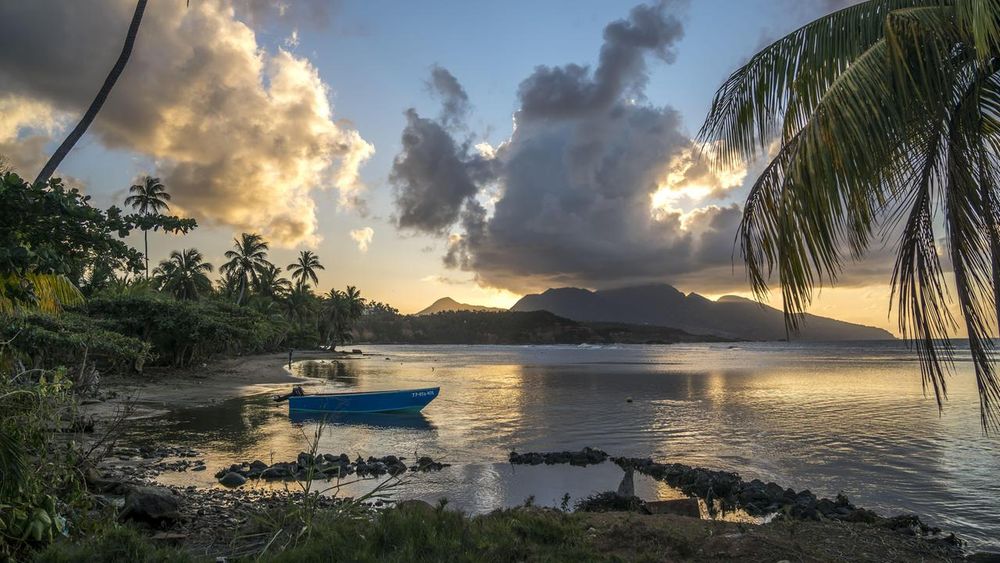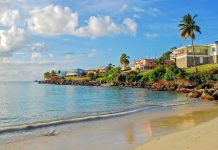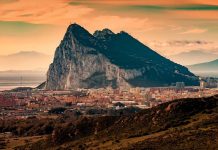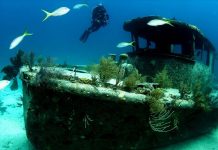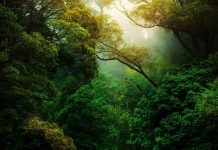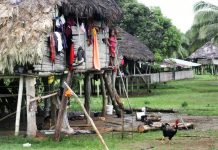Dominica, a paradise for naturalists and adventure enthusiasts.The island is less crowded as it lacks those white-sand beaches that are so favored by visitors to the Caribbean. Dominica has a lush mountainous interior of rainforests, waterfalls, lakes, hot springs and more than 200 rivers. Most of these cascade over steep cliff faces en route to the coast. Hiking is the best way to see this island. The island has an interesting collection of British, French and West Indian cultural traditions.
The island is covered with tropical rainforests that cover the slopes of the mountainous island. Its many rivers fmake for numerous mountain pools and waterfalls. In 1493 Christopher Columbus and his crew were the first Europeans to sight Dominica. He sailed past the island on a Sunday (Domingo in Spanish), which is how the name Dominica came about.
Dominica is part of the Windward Islands. The Windwards are made up of four main islands: Dominica, Grenada, St. Lucia, and St. Vincent and the Grenadines. These islands are not considered to be the heavy tourist attractions, as compared to their Caribbean neighbors, but this is a plus, as they are far enough off the beaten path to afford the adventurous traveler the pristine natural beauty this region has to offer. Dominica has been inhabited for over 5,000 years, with various native tribes calling the island home over the millennia.
The original settlers, the Ortoroid people, came, went and were replaced by the Igneri in about 400 AD. They lived here peacefully for the next thousand years, until the aggressive Carib tribe made their way up from South America and took over the island in 1400. Christopher Columbus was the first European to find the island, and he named it Dominica because he arrived here on a Sunday, November 3rd, 1493. As a result, the 3rd of November remains a national holiday here.
Dominica offers some of the most unique and breathtaking scenery in the world. The island only covers 290 square miles, measuring 29 miles from north to south and 16 miles from east to west. But the amount of scenery crammed on to this tiny island paradise is enough to take up the better part of a year, if only you had the time. Volcanic fissures form a perennially boiling lake, the second largest such lake in the world. Rare breeds of bird, including Jacquot and Sisserou parrots, make their home here. A local myth has it that there are 365 rivers in Dominica, one to explore each day of the year.You will want to pack good shoes for your excursion to Dominica, as the best way to see everything there is to see here is by hiking. Scuba divers will also be in paradise here, as some beautiful coral reefs and rare fish can be seen in Dominica’s mind-blowing crystal clear waters. Most travelers spend the majority of their time in Roseau, Dominica’s capital city, which is located along the southwest corner of the island. The rainforest is a little more inland, covering 17,000 acres in the southern part of Dominica. English is widely spoken, as it is the official language of Dominica, but you’ll be able to brush up on your French patois, if you are so inclined. The Creole influence is heavy here, in everything from crafts to local foods.
Cruise ships dock in Roseau, Dominica’s capital city, at the Port Of Roseau. There is easy road access from the port to the rest of the island. The alternate port that serves Roseau is the Woodbridge Bay Deepwater Harbour. The Cabrits cruise ship port at the Cabrits Historical and Marine Park is yet another alternate port serving the northwest end of the island Taxis are available, and the local government regulates the price, so you don’t have to worry about being overcharged (for an island tour, expect to pay $150). Roseau Rental cars are an option, as well. There is a fee of about eleven dollars to obtain a license, and over 300 miles of paved roads around the island. Be advised though, that driving is on the left side of the road, not the right. You can use Budget Rent-a-car (tel. 767/449-2080) or Avis (tel. 767/448-2481and local outfits such as Bonus Rentals (767-448-2650) and Island Car Rentals (767-448-2886). Minibuses are more affordable than the above options, but you’ll be sharing them with schoolchildren and local villagers, who use them to get in and out of Roseau. Prepare to spend about $3 for a trip from Portsmouth in the northwest corner of the island to Roseau, which is in the southwest.
Attractions
Dominica’s main attraction is its natural beauty. While its beaches are below average compared to the splendor of other Caribbean locales, the nature hikes and winding rivers here are second to none. A good place to start would be to pay a visit to the Dominica Tourist Office (tel. 767/448-2186). You will get all the information you need to start you on your way.Hiking should be done only with experienced guides. Finding a guide won’t be hard, most likely they will find you. Head into the Morne Trois Pitons National Park, 17,000 acres of the most interesting sites you will see. Among them, lava covered by a thin crust, the second largest boiling lake in the world, and rare breeds of parrot and monkey.
Do your best to avoid hiking after a rainy day, because the trails can be treacherous when slippery. Roseau has numerous attractions, starting with its marketplace, a good spot to eye souvenirs, produce and the local action. Other hot spots include The Roseau Cathedral, The Botanical Garden (check out the parrot aviary) and the Dominica Museum. Easy a 20-minute trail in the Morne Trois Pitons National Park leads to the Emerald Pool – complete with 50 ft. waterfall. Other easy strolls include Trafalgar Falls and Cabrits. Challenging Plan to spend the whole day on these trails: Boiling Lake (six hours roundtrip), which leads to the water-filled crater, steamingly sulfurous. Others include Trois Pitons and Soufriere Volcano. Experienced guides are highly recommended. One of the attractions of Morne Diablotin National Park is its habitat for one of the rarest Amazonian parrots the Sisserou Parrot.
Roseau:
While Roseau (pronounced ‘rose-oh’) is one of the region’s poorer capitals, it’s not the grimmest. Shopkeepers wash down the sidewalks every morning, the streets are lined with old stone-and-wood buildings, and mountains form a verdant backdrop.The city has rebuilt its hurricane-damaged waterfront and now boasts a new cruise ship dock and promenade. There are a growing number of modern cement structures too, since this is a functional market town. For the most part walking the quieter backstreets feels like stepping back in time.
Carib Territory:
The 3700ac (1497ha) Carib Territory is home to most of Dominica’s 3000 Carib Indians. After exposure to European-borne diseases in the 17th century, the Carib population here fell to just a few hundred, but that was fortunate compared to the decimation Caribs suffered on other Caribbean islands.In the mid-18th century the remaining few were removed to a small ‘reserve’ – the nucleus of the present-day Territory. Although their numbers have increased since then, their culture has been eroded by Roman Catholicism and the English and French Creole languages.
Layou River Area:
The Layou River, Dominica’s longest, empties into the sea just south of St Joseph, at the centre of the west coast. The river basin is a peaceful rural area, with bamboo leaning over the river banks and banana and coconut trees at the side of the road. When it’s not running strong, the river is a popular place for freshwater swimming. St Joseph, a simple fishing village of 2600 people, rises up the slope from a small black-sand beach, but the area’s best beach is farther north at the Castaways Beach Hotel in Mero.
Portsmouth:
Portsmouth, Dominica’s second-largest town, sits on the banks of Prince Rupert Bay. Columbus entered the bay during his fourth voyage to the New World in 1504. Portsmouth centre doesn’t have any sights per se, but there are a couple of oddities to check out. For one thing, there’s the small but colourful monument at the bus stop dedicated to Lord Cathcart ‘who died of the bloody flux off Dominica in 1741’. Nearby, there’s a line of shipwrecks piled up in the shallow waters at the back of the police station.
Morne Bruce:
Morne Bruce is a rather exclusive hillside suburb situated to the southeast of Roseau. Although it has a couple of places to stay, there’s not much reason to stay overnight. Most people who venture up this way do so for the panoramic hilltop view of Roseau and its surroundings.One way to get to the viewpoint is to drive up and park below the president’s office. You can also hike up from the botanical gardens; the trail begins just east of the parrot aviary and takes about 15 minutes to walk. Either way will give you a pretty view.
Morne Trois Pitons National Park:
This impressive national park, most of which is primordial rainforest, is situated in the southern half of the island, encompassing 17,000ac (6880ha) of Dominica’s mountainous volcanic interior and containing many of the island’s top wilderness sites.The tropical ecology varies from jungles thick with tall, pillar-like gommier trees to the stunted cloud forest cover on the upper slopes of Morne Trois Pitons itself. Emerald Pool, at the northernmost tip of the park, is a small basin in a lush green setting at the foot of a gentle waterfall.
Scotts Head:
Scotts Head, a tiny fishing village of only 800 souls, is a fun sort of place to kick around. It has a gem of a setting along the gently curving shoreline of Soufrière Bay (the rim of a sunken volcanic crater) and a scenic mountain backdrop.Scotts Head is just a 30-minute drive along the road skirting the coast south of Roseau, and divers can check out Scotts Head Drop, a shallow coral ledge that drops abruptly to a depth of over 50m (160ft) and has a wall of tube sponges and soft corals.
Cabrits National Park:
On the northwestern coast, Portsmouth is Dominica’s second-largest settlement. Once here, you can row up the Indian River in native canoes, visit the ruins of old Fort Shirley in Cabrits National Park, and bathe at Sandy Beach on Douglas Bay and Prince Rupert Bay.(tel. 767/448-2732), on Dominica’s northwestern coast, immediately adjacent to Douglas Bay, is a 525-hectare (1,313-acre) protected site, only about 25% of which is devoted to dry land. Here you’ll find low-rising hills, tropical forests, swampland, volcanic-sand beaches, coral reefs, and the sprawling ruins of a fortified, 18th-century garrison of British, then French, construction. This is one of the area’s great natural attractions, and if your time is limited, you may want to head here even if you skip everything else in Dominica. The park’s land extends over a panoramic promontory formed by the low-rising twin peaks of extinct volcanoes (known as East Cabrit and West Cabrit, respectively), overlooking beaches, with Douglas Bay on one side and Prince Rupert Bay across the headland. The marine section of the park extends over the teeming marine life of the shallow waters of Douglas Bay.
Park underwater:
If you want to explore the park underwater, we strongly encourage you to take one of the scuba or snorkeling trips organized by the officially designated dive operator for the park, Cabrit’s Dive Center, Picard Estate, Portsmouth (tel. 767/445-3010). If you’re interested in hiking, you’ll find about 3km (2 miles) of trails, each clearly marked with brown and yellow signs, pointing out the geological and architectural highlights of the park. Foremost among these is Fort Shirley, a forbidding-looking hulk that was last used as a military post in 1854. The park’s Welcome Center (tel. 767/448-2732) contains a small on-site museum, (open daily 9am to 5pm, free admission) that highlights the natural and historic aspects of the park. The staff will make suggestions about the trails you might want to follow, but since the surface of the park is relatively limited in scope, it’s hard to get lost. Signs point from the welcome center to the ruins of Fort Shirley, and to the low summits of the East and West Cabrit hills, neither of which rises more than about 150m (500 ft.) above sea level.
Beaches:
Dominica has some of the worst beaches in the Caribbean. Most of them are rocky with gray-black volcanic sand, though they are still good for diving or snorkeling in the turquoise waters surrounding the island. The best beach on the island is located on the northwest coast. But if you realy need to hit the beach, go to Picard Beach is approximately a 2 mile (3km), strip of grayish sand. On the northeast coast, there are four beaches–L’Anse Noire, Hodges Beach, Woodford Hill Bay, and Hampstead Beach, that are among the island’s most beautiful, although none of these are great for swimming. Beaches are pale in comparison to those on other Caribbean Islands. Most of the prettiest ones are extremely difficult to get to without expert hiking skills. Scuba Diving Because the water is so crystal clear here, with visibility up to 100 feet below, a scuba dive is a must while on Dominica. Near Roseau, on the southwestern side of the island, you will find all kinds of rare fish and plant life. For the best dive resort on the island, the hands-down winner is the Dive Centre (tel. 767/448-2188). Beyond the scuba diving, the Centre also offers a whale and dolphin watch, a three and a half hour excursion made well worth it when you spot those amazing sea mammals.





















